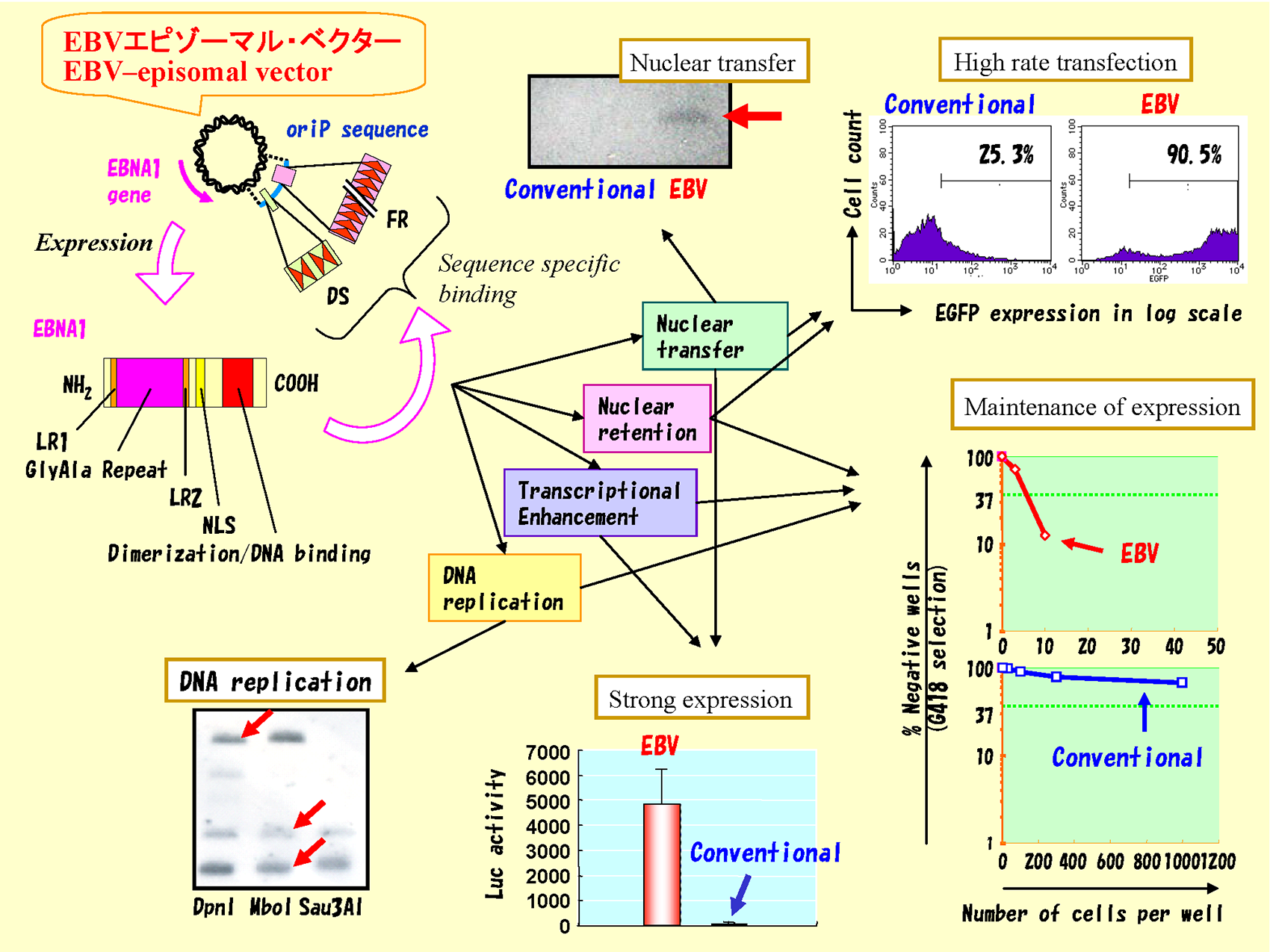プロジェクトのご紹介 12 - Project 12 -
EBV- エピゾーマルベクターによる外来遺伝子の高効率導入、高発現、長期間持続の機構解明
Mechanisms underlying the high-rate transfection, high-level expression, and long-term maintenance of exogenous genes mediated by the Epstein-Barr virus-based episomal vector

エプスタイン・バール・ウイルス(EBV)のoriP 配列とEBNA1 遺伝子は、潜伏感染しているヒト細胞においてウイルスゲノムDNA が複製保持されるのに必須の役割を果たす。
EBNA1 は配列特異的にoriP に結合し、このoriP を有するエピゾームDNA の複製、核移行、核マトリックスと染色体への結合を促進し、また転写を増強する。
そこで、EBNA1 遺伝子とoriP を有するプラスミドベクター(EBV エピゾーマル・ベクター)を
非ウイルス的導入法にて細胞に導入すると、高効率導入、高発現と長期間維持が可能となる。
我々は、EBNA1/oriP の素機能の貢献をマルチスケール操作にて解析した。
さらにこの成果を元に、遺伝子の機能解析や、種々疾患に対する分子標的療法の候補遺伝子の解明等への応用も行っている。
The Epstein-Barr virus (EBV) nuclear antigen 1 (EBNA1) gene and oriP sequence are essential for the replication and maintenance of EBV genomic DNA in human cells that are latently infected with the virus.
Through binding to oriP in a sequence-specific fashion, the EBNA1 promotes replication of the episomal DNA bearing oriP, promotes nuclear transfer of the oriP-bearing episome, mediates binding of the oriP-bearing episomal DNA to the chromosomes/chromatin, and positively regulates transcription.
Thus, plasmid DNA containing the EBNA1 gene and oriP (EBV-based episomal vectors) enables highly efficient gene transfer, strong expression of exogenous gene, and long-term maintenance of the episomes, after transfected into mammalian cells via a nonviral gene transfer vehicles.
By means of the multiscale manipulation procedures, we analyzed differential contribution of each function of EBNA1/oriP. Moreover, we have performed functional analyses of genes as well as exploration of target genes for therapeutic molecular targeting for variety of diseases.
一部プロジェクトのご紹介 - See some projects among others -
- 新型コロナウイルス・オミクロン変異株に対する茶カテキン類の効果
Effects of tea catechin-related compounds on Omicron subvariants of SARS-CoV-2 - 腫瘍微小環境の低pHはプロトンセンサーGたんぱく共役レセプターをを介して腫瘍のPDL-1の発現を低下させる
Extracellular acidity in tumor tissue upregulates programmed cell death protein 1 expression on tumor cells via proton-sensing G protein-coupled receptors - 緑茶カテキン、カテキン誘導体、およびガレート型テアフラビンによる新型コロナウイルスの試験管内での有意な不活化;紅茶と緑茶による試験管内での唾液中の新型コロナウイルスの迅速な不活化
Significant Inactivation of SARS-CoV-2 by a Green Tea Catechin, a Catechin-derivative and Galloylated Theaflavins in vitro; Rapid Inactivation in vitro of SARS-CoV-2 in Saliva by Black Tea and Green Tea - 新規多孔性3Dスキャフォールドと直接誘導骨芽細胞を用いた骨再生
Nanogel tectonic porous 3D scaffold for direct reprogramming fibroblasts into osteoblasts and bone regeneration - TGFR阻害剤による骨芽細胞のケミカル・ダイレクト・リプログラミング
Chemical direct reprogramming of human fibroblasts into osteoblasts by a TGFR blockade - 筋芽細胞のダイレクト・リプログラミングと筋管形成
Direct reprogramming of functional myoblasts that are capable of forming multinuclear myotube - シュワン細胞のダイレクト・リプログラミングと末梢神経損傷の再生
Direct reprogramming of functional Schwann cells that promote regeneration of peripheral nerve - 褐色脂肪のダイレクト・リプログラミングと代謝疾患の制御
Direct reprogramming of functional brown adipocytes that control metabolic diseases - 骨芽細胞のダイレクト・リプログラミングと骨再生
Direct reprogramming of functional osteoblasts that regenerate bone tissue - IL-21 によるアレルギー応答の制御とその分子機構
IL-21-mediated regulation of allergic responses and its molecular mechanisms - IL-27 による NK 細胞活性化と ADCC を介した腫瘍抑制
IL-27 augments NK cytotoxicity and induces ADCC-based tumor suppression - EBV- エピゾーマルベクターによる外来遺伝子の高効率導入、高発現、長期間持続の機構解明
Mechanisms underlying the high-rate transfection, high-level expression, and long-term maintenance of exogenous genes mediated by the Epstein-Barr virus-based episomal vector - 細胞の分化と初期化に伴う染色体エピジェネティック修飾の解析
Analyses of epigenetic modification of chromosomes upon cell differentiation and reprogramming

